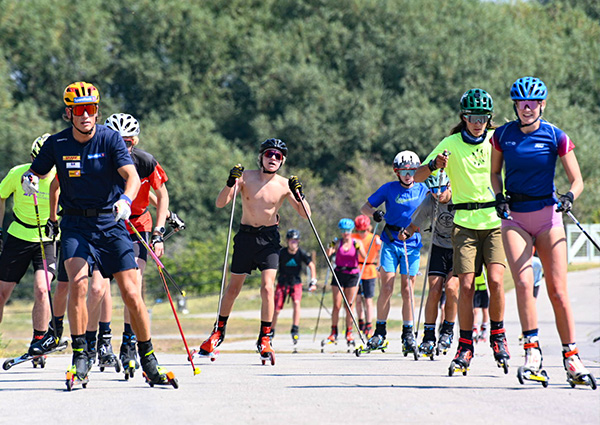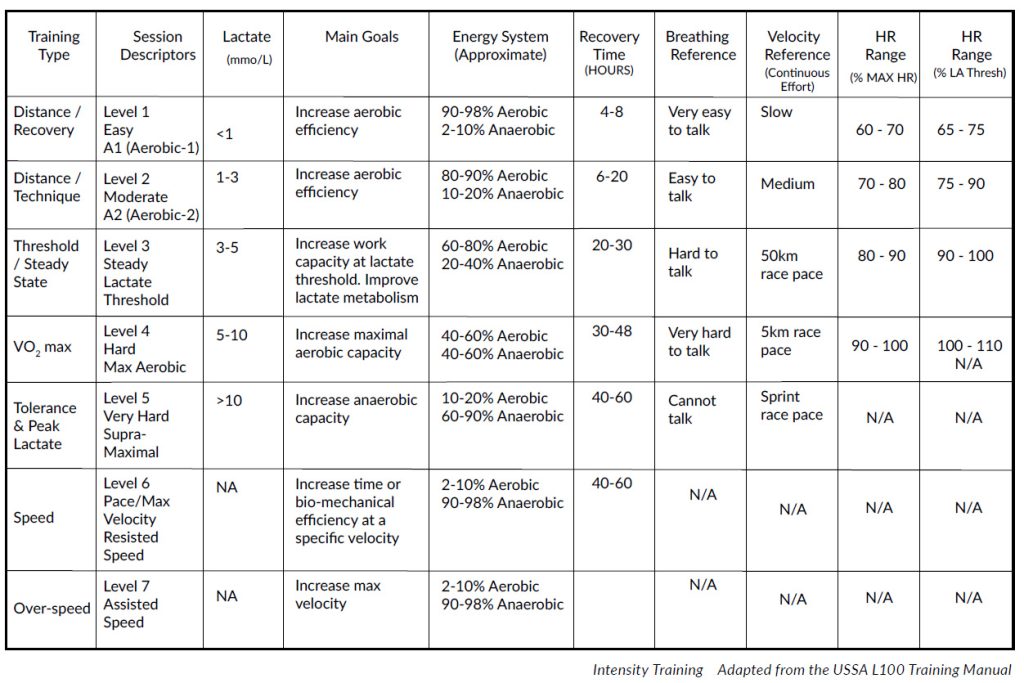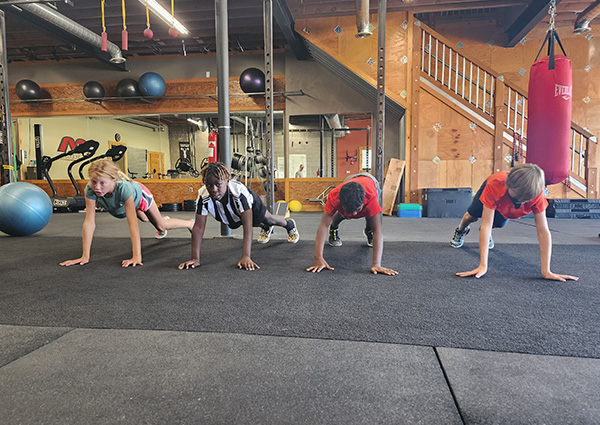by Pete Vordenberg, former US Ski Team Head Coach
Continued from Part 2 in the February 2024 issue of the TUNA News
Intensity Training
In a million ways it has been stated that you get out of a thing, what you put into it. Perhaps most famously, As ye sew, so shall ye reap. In skiing this is famously true. And it is one of the most addicting, pleasurable and satisfying parts of the process of ski training. When you do the work and get your rest, you will improve. Like the training concept of super compensation itself, you are rewarded with measurable, pleasurable improvements for the quality of effort you invest. Skiing is wonderful in that you can do it at the level you want. You can ski simply for the day’s outing, enjoy it socially, recreationally, and you can set your sights higher, on junior national level racing, on collegiate racing, or you can litterally go for The Gold. Recognize though, that each goal comes with requisite investments.
No matter the level at which you practice this sport, it is truly the investment itself that is the gold. Regardless of outcome, the quality of the time you invest contains 99.9% of what this sport has to offer – and it is where the beam of your attention must shine.
In the previous two articles we have talked about goals, and the path toward those goals. This article builds on those.
While a majority of ski training is highly aerobic, and thus low intensity training, higher intensity training is a key component to improvement. Besides the physiologic adaptations that take place only in low intensity, longer distance workouts, it is also to be prepared and rested for harder workouts that makes going easy enough so important. To go fast when it is time to go fast, you must go easy when it is time to go easy.
Too often the pace of easy-distance training is too fast, and the result is the speed of harder intensity workouts is then too slow. When this happens, and the pace and intensity of all workouts degrades to a middle ground, improvement plateaus dramatically. You can’t learn to go fast by always going medium.
Beyond the aerobic training levels of 1 and 2 come (you guessed it!) levels 3 and 4. These 4 training intensities make up the bulk of cross-country ski training. In addition there is strength training, mental training, often physical therapy and always lots of good rest and recovery. In this article we focus on levels 3 and 4.

Level 3 Training
Description
Threshold sessions are designed as sessions, which can span across a wide variety of sets and reps. Level 3 intervals are executed at or below the anaerobic threshold (75-90 % of max heart rate). One is not supposed to accumulate lactic acid. One should feel like one could go faster and longer for every interval. Therefore, they have built in to them sufficient rest or slow work to allow complete recovery between reps or sets. This design format ensures that there is no accumulated fatigue between sets or reps allowing maintenance of quality rather than a reduction in performance caused by fatigue.
Main Goals
The aim of these sessions is to get the body used to working intermittently above threshold and practice recovering after each effort. Gradually this type of training stimulates improved efficiency and increased recovery rates around threshold allowing the body to gradually increase the work it can do without accumulating progressive amounts of lactate.
Ingrain proper technique from repetitive correct biomechanical patterning. This is a fantastic opportunity to focus on making specific technical improvements as you are going fast, but not so hard that keeping a clear focus on technique is challenging. This sort of intensity and speed is a very productive one.
Physiological Changes
The major goals of these sessions are to improve aerobic efficiency and aerobic capacity. This is achieved by a combination of:
- Increasing cardiac efficiency and oxygen transport both from the lungs and into the muscle cells. Leading to an increase aerobic efficiency “around” threshold and an increase in aerobic work capacity at threshold (level 3)
- Increasing cardiac output (both by increased cardiac efficiency and maximal capacity)
- Decrease reliance on anaerobic metabolism at gradually increasing workloads.
Example Sessions
They span the continuum between continuous to short interval sessions: Brief descriptions and session details are given below:
- Intent: Continuous work at threshold (Steady state sessions)
Training progressions are achieved by increasing the length of time at this load.
For example: 30-60 minutes non-stop skating or running. Lactates around 4 mmol/L the whole time. - Intent: Longer intervals with controlled intensity (Level 3), and moderate rest.
For example: 3×10 minutes, 4×8 minutes, 3×15 minutes, ladder of long intervals. Rest 1-3 minutes.
Lactate at the end of each interval should be around 3-5 mmol/L. - Intent: Shorter intervals also with controlled intensity, with very short rest.
For example: 2x12x200 meters with 20-30 seconds rest, or 2x8x400 meters with 20 – 60 seconds rest.
Lactate around 3-5 mmol/L at the end of the workout.
This sort of workout is important to learning a new speed while still keeping the overall intensity of the session at Level 3.

Level 4 Training
Description
Level 4 intervals are executed at or above the anaerobic threshold, which is typically between 85%-95% of max heart rate. (Note: these heart rate values can vary a lot with training the amount and direction varies with the athletes’ history as well as the volume and intensity base of their training schedule). The reps and sets of these types of sessions are designed in such a way that during each interval and during the workout there will be an accumulation of lactic acid often between 5-10 mmol/L by the end of the session.
Main Goals
The main goal however is to maximally challenge the aerobic as opposed to the anaerobic system. To do this, the distance or time governing each rep needs to be a minimum of 3 minutes and the athlete must be able to perform each rep at the same velocity and with the same technique throughout the session. To control the overall intensity of the session rest is usually equal to the length of the interval or determined by how long it takes for the athletes’ heart rate to fall below their A1 heart rate (HR at 1 mmol/L lactate from testing).
Ingrain proper technique.
Physiological Changes
The major physiological goals of these sessions are to improve VO2 max and maximal aerobic work capacity. This is achieved by a combination of:
- Increased cardiac output (both by increased stroke volume and the efficiency of cardiac output under maximal load)
- Increased maximal tidal volume of the lungs
- Increased maximal O2 transfer rates both from the lungs to the blood and from the blood to the muscles.
Example Sessions
The level 4 intervals will typically use 4 to 5 reps of 3-6 minutes, although the rep length can be extended as far as 10-15 minutes with fewer rep numbers – more often these are categorized as time trials.
- 5 – 15 Km Time trials
- Out of season races

Carrying Out the Plan
Organizing training within a week, a month and over years is best done with the guidance of a trained and experienced coach. The internet and general endurance-sport ether is filled with tid-bits of half-information, rumors and bald-faced lies. The articles writen here for TUNA are not stand-alone pieces, but rather general and basic outlines of what training for the sport of cross-country skiing entails. Fitting it together for an individual and a team is an art and science built on experience.
Furthermore, carrying the training out is a discipline. It is a discipline of going the right pace for each workout. Typically this is the discipline of not letting your ego or other distractions increase your pace above what it should be. And having the patience to let your body rest and recover enough between workouts. Similarly the patience to progress gradually and in-line with a thoughful, progressive increase in training load over your development. Matt Whitcomb (US Ski Team Head Coach) told me reciently that several top athletes had to reset their training after having progressed too quickly as juniors. To do this they dialed their training back significantly over two years and only reciently have begun to make progress again.
One might think it is often the discipline to push harder, go further, and do more. This is rare. With motivated athletes this is generally not the case, and the challenge is going slow enough when that is what is called for, and resting long enough when that is what is called for.
That cannot be over stated.
Additionally it must be made clear that high goals require a high level of dedication, determination, discipline and work. Those athletes that want to achieve big things can expect to train a lot, train hard and also rest a lot, eat healthily, sleep well, practice mental training, including visualization, and relaxation and live the skier’s life. This is not an imbalanced and selfish life, there is time for study, friends, family and adventure. They all intwine into a wonderful lifestyle.
Make no mistake, there are sacrifices and there is hard work. But rather than be a chore and a drudgery, for those athletes that love to race, who think hard training is fun, and want to take racing far, this work, this discipline, this rest makes up a joyous, long and healthy lifestyle.